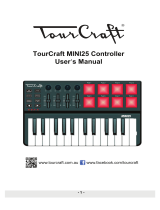
2
Contents
Introduction ........................................................................... 3
About the owner’s manual ..........................................................3
Main features ..............................................................................3
Block diagram
......
....................................................................... 4
Controls and connections .................................................... 5
Front panel controls ....................................................................5
Rear panel connections
.............................................................. 7
Turning the power on/off .............................................................8
Playing the minilogue xd .................................................... 10
Selecting and playing a program ..............................................10
Playing in Keyboard mode ........................................................ 11
Using Favorites
.........................................................................12
Playing the sequencer
..............................................................13
Programs .............................................................................. 14
Program architecture ................................................................14
Creating sounds
.......................................................................15
Saving a program .....................................................................16
Basic parameters ................................................................ 17
MASTER controls .....................................................................17
VCO 1/VCO 2/MULTI ENGINE section ....................................18
MIXER section
..........................................................................22
FILTER section .........................................................................23
EG/LFO section ........................................................................24
EFFECTS section .....................................................................26
Sequencer
................................................................................27
Edit mode ............................................................................. 33
How to enter the Edit mode ......................................................33
Edit mode parameter list ...........................................................34
PROGRAM EDIT mode ...........................................................35
SEQ EDIT mode ....................................................................... 40
GLOBAL EDIT mode ................................................................43
Other functions .................................................................... 50
Tuning .......................................................................................50
Poly-chain .................................................................................51
Restoring the factory settings ...................................................52
Shortcuts using the SHIFT button ............................................52
Using with other devices .................................................... 55
Making connections with the SYNC IN/OUT jacks ...................55
Making connections with the CV IN jacks ................................56
Connecting to a MIDI device or a computer .............................56
Data list ................................................................................ 59
Effects list .................................................................................59
Program list ..............................................................................61
Specications ...................................................................... 66
MIDI Implementation Chart ................................................. 68





















